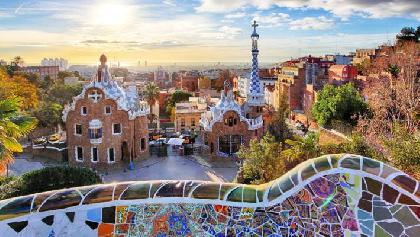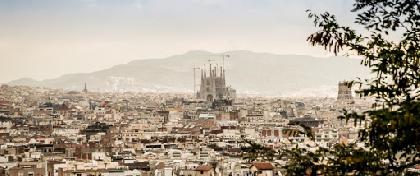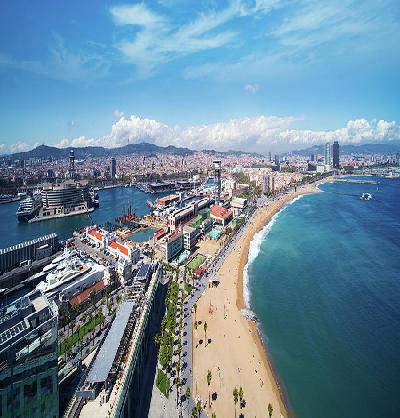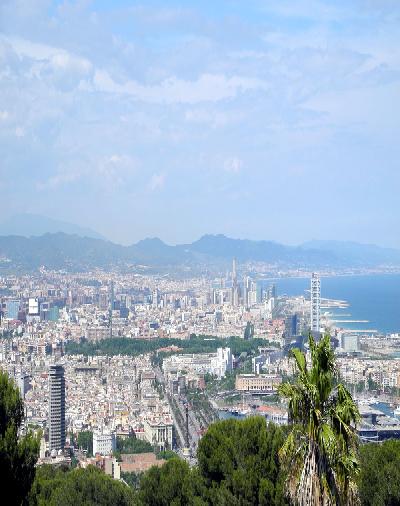Barcelona is a Spanish city, capital of the autonomous community of Catalonia and the second largest city in the country, with a population of 1,620,943 within its administrative limits. The urban area of Barcelona extends beyond the administrative city limits with a population of around 4.5 million being the sixth-most populous urban area in the European Union after Paris, London, the Ruhr, Madrid and Milan. About five million people live in the Barcelona metropolitan area. It is also the largest metropolis on the Mediterranean Sea. It is located on the Mediterranean coast between the mouths of the rivers Llobregat and Besòs and is bounded to the west by the Serra de Collserola ridge (512 metres (1,680 ft)).

Founded as a Roman city, Barcelona became the capital of the County of Barcelona. After merging with the Kingdom of Aragon, Barcelona continued to be an important city in the Crown of Aragon. Besieged several times during its history, Barcelona has a rich cultural heritage and is today an important cultural centre and a major tourist destination. Particularly renowned are the architectural works of Antoni Gaudí and Lluís Domènech i Montaner, which have been designated UNESCO World Heritage Sites. The headquarters of the Union for the Mediterranean is located in Barcelona. The city is known for hosting the 1992 Summer Olympics as well as world-class conferences and expositions and also many international sport tournaments.
Barcelona is today one of the world's leading tourist, economic, trade fair/exhibitions and cultural-sports centres, and its influence in commerce, education, entertainment, media, fashion, science, and the arts all contribute to its status as one of the world's major global cities. It is a major cultural and economic centre in southwestern Europe (Iberian Peninsula), 24th in the world (after Zürich, before Frankfurt) and a growing financial centre (Diagonal Mar and Gran Via). It is the fourth economically powerful city by GDP in the European Union and 35th in the world with an output amounting to €177 billion. As of 2009 the city was ranked Europe's third and one of the world's most successful as a city brand. At the same time, the city was ranked Europe's fourth best city for business and fastest improving European city, with growth improved by 17% per year. Barcelona is a transport hub with one of Europe's principal seaports, an international airport which handles above 35 million passengers per year, an extensive motorway network and a high-speed rail line with a planned link to France and the rest of Europe.
Names
The name Barcelona comes from the ancient Iberian Phoenician Barkeno, attested in an ancient coin inscription in Iberian script as in Ancient Greek sources as Βαρκινών, Barkinṓn; and in Latin as Barcino Barcilonum and Barceno.
During the Middle Ages, the city was variously known as Barchinona, Barçalona, Barchelonaa, and Barchenona.
Some sources say that the city may have been named after the Carthaginian general Hamilcar Barca, who was supposed to have founded the city in the 3rd century BC.
Barcelona's name is sometimes abbreviated as 'Barna'. Nowadays, foreign people sometimes mistakenly refer to Barcelona as 'Barça', the popular name of the F.C. Barcelona sports club. Some people (mainly in Spanish/Catalan) also use 'BCN', often written 'Bcn', which actually corresponds to the IATA airport code of the Barcelona-El Prat Airport. The city is also referred to as the "ciudad condal" in Spanish and "ciutat comtal" in Catalan, owing to its past as home to the Count of Barcelona.
History Of Barcelona

The founding of Barcelona is the subject of two different legends. The first attributes the founding of the city to the mythological Hercules. The second legend attributes the foundation of the city directly to the historical Carthaginian Hamilcar Barca, father of Hannibal, who named the city Barcino after his family in the 3rd century BC.
In about 15 BC, the Romans redrew the town as a castrum (Roman military camp) centred on the "Mons Taber", a little hill near the contemporary city hall (Plaça de Sant Jaume). Under the Romans, it was a colony with the surname of Faventia, or, in full, Colonia Faventia Julia Augusta Pia Barcino or Colonia Julia Augusta Faventia Paterna Barcino. Pomponius Mela mentions it among the small towns of the district, probably as it was eclipsed by its neighbour Tarraco (modern Tarragona), but it may be gathered from later writers that it gradually grew in wealth and consequence, favoured as it was with a beautiful situation and an excellent harbour. It enjoyed immunity from imperial burdens. The city minted its own coins; some from the era of Galba survive.
Some important Roman ruins are exposed under the Plaça del Rei, its entrance located by the city museum (Museu d'Història de la Ciutat); the typically Roman grid plan is still visible today in the layout of the historical centre, the Barri Gòtic ("Gothic Quarter"). Some remaining fragments of the Roman walls have been incorporated into the cathedral. The cathedral, also known as the Basilica La Seu, is said to have been founded in 343. The city was conquered by the Visigoths in the early 5th century, becoming for a few years the capital of all Hispania. After being conquered by the Arabs in the early 8th century, it was conquered in 801 by Charlemagne's son Louis, who made Barcelona the seat of the Carolingian "Hispanic March" (Marca Hispanica), a buffer zone ruled by the Count of Barcelona.
The Counts of Barcelona became increasingly independent and expanded their territory to include all of Catalonia. In 1137, Aragon and the County of Barcelona merged in dynastic union by the marriage of Ramon Berenguer IV and Petronilla of Aragon, their titles finally borne by only one person when their son Alfonso II of Aragon ascended to the throne in 1162. His territories were later to be known as the Crown of Aragon, which conquered many overseas possessions and ruled the western Mediterranean Sea with outlying territories in Naples and Sicily and as far as Athens in the 13th century. The forging of a dynastic link between the Crowns of Aragon and Castile marked the beginning of Barcelona's decline. The Bank of Barcelona, probably the oldest public bank in Europe, was established by the city magistrates in 1401. It originated from necessities of the state, as did the Bank of Venice (1402) and the Bank of Genoa (1407)

The marriage of Ferdinand II of Aragon and Isabella I of Castile in 1469 united the two royal lines. Madrid became the centre of political power whilst the colonisation of the Americas reduced the financial importance (at least in relative terms) of Mediterranean trade. Barcelona had always been the stronghold of Catalan separatism and was the center of the Catalan Revolt (1640–52) against Philip IV of Spain. The great plague of 1650–1654 halved the city's population.
In the 18th century, a fortress was built at Montjuïc that overlooked the harbour. In 1794, this fortress was used by the French astronomer Pierre François André Méchain for observations relating to a survey stretching to Dunkirk that provided the official basis of the measurement of a metre. The definitive metre bar, manufactured from platinum, was presented to the French legislative assembly on 22 June 1799. The Napoleonic wars left the province ravaged, but the postwar period saw the start of industrialization.
During the Spanish Civil War, the city, and Catalonia in general, were resolutely Republican. Many enterprises and public services were "collectivised" by the CNT and UGT unions. As the power of the Republican government and the Generalitat diminished, much of the city was under the effective control of anarchist groups. The anarchists lost control of the city to their own allies, the Communists and official government troops, after the street fighting of the Barcelona May Days. The fall of the city on 26 January 1939 caused a mass exodus of civilians who fled to the French border. The resistance of Barcelona to Franco's coup d'état was to have lasting effects after the defeat of the Republican government. The autonomous institutions of Catalonia were abolished, and the use of the Catalan language in public life was suppressed. Barcelona remained the second largest city in Spain, at the heart of a region which was relatively industrialised and prosperous, despite the devastation of the civil war. The result was a large-scale immigration from poorer regions of Spain (particularly Andalusia, Murcia and Galicia), which in turn led to rapid urbanisation. Barcelona hosted the Olympic Games in 1992, which helped revitalise the city.
Barcelona is located on the northeast coast of the Iberian Peninsula, facing the Mediterranean Sea, on a plain approximately 5 km (3 mi) wide limited by the mountain range of Collserola, the Llobregat river to the southwest and the Besòs river to the north. This plain covers an area of 170 km2 (66 sq mi), of which 101 km2 (39.0 sq mi) are occupied by the city itself. It is 120 kilometres (75 miles) south of the Pyrenees and the Catalan border with France.
Tibidabo, 512 m (1,680 ft) high, offers striking views over the city and is topped by the 288.4 m (946.2 ft) Torre de Collserola, a telecommunications tower that is visible from most of the city. Barcelona is peppered with small hills, most of them urbanised, that gave their name to the neighbourhoods built upon them, such as Carmel (267 m), Putxet (181 m) and Rovira (261 m). The escarpment of Montjuïc (173 m), situated to the southeast, overlooks the harbour and is topped by Montjuïc castle, a fortress built in the 17–18th centuries to control the city as a replacement for the Ciutadella. Today, the fortress is a museum and Montjuïc is home to several sporting and cultural venues, as well as Barcelona's biggest park and gardens.
The city borders on the municipalities of Santa Coloma de Gramenet and Sant Adrià de Besòs to the north; the Mediterranean Sea to the east; El Prat de Llobregat and L'Hospitalet de Llobregat to the south; and Sant Feliu de Llobregat, Sant Just Desvern, Esplugues de Llobregat, Sant Cugat del Vallès, and Montcada i Reixac to the west.

Barcelona has a Mediterranean climate (Köppen climate classification: Csa), with mild, humid winters and warm, dry summers. Its average annual temperature is 20 °C (68 °F) during the day and 11 °C (52 °F) at night. The average annual temperature of the sea is about 18 °C (64 °F). In the coldest month – January, the temperature typically ranges from 7 to 17 °C (45 to 63 °F) during the day, 2 to 10 °C (36 to 50 °F) at night and the average sea temperature is 13 °C (55 °F). In the warmest month – August, the typical temperature ranges from 25 to 31 °C (77 to 88 °F) during the day, about 20 °C (68 °F) at night and the average sea temperature is 25 °C (77 °F). Generally – the summer / "holiday" season lasts about six months, from May to October. Two months – April and November – are transitional; sometimes the temperature exceeds 20 °C (68 °F), with an average temperature of 17–18 °C (63–64 °F) during the day and 8–9 °C (46–48 °F) at night. December, January and February are the coldest months, with average temperatures around 14 °C (57 °F) during the day and 5 °C (41 °F) at night. Large fluctuations in temperature are rare, particularly in the summer months.
Barcelona has average several rainy days per month (≥ 1 mm) and annual average relative humidity is 72%, ranging from 69% in July to 75% in October. Sunshine duration is 2,524 hours per year, from 138 (average 4.5 hours of sunshine a day) in December to 310 (average 10 hours of sunshine a day) in July.
Main sights of Barcelona
The Barri Gòtic (Catalan for "Gothic Quarter") is the centre of the old city of Barcelona. Many of the buildings date from medieval times, some from as far back as the Roman settlement of Barcelona. Catalan modernista architecture (related to the movement known as Art Nouveau in the rest of Europe), developed between 1885 and 1950 and left an important legacy in Barcelona. Several of these buildings are World Heritage Sites. Especially remarkable is the work of architect Antoni Gaudí, which can be seen throughout the city. His best-known work is the immense but still unfinished church of the Sagrada Família, which has been under construction since 1882, and is still financed by private donations. As of 2007, completion is planned for 2026.
Barcelona was also home to Mies van der Rohe's Barcelona Pavilion. Designed in 1929 for the International Exposition for Germany, it is an iconic building that came to symbolize modern architecture as the embodiment of van der Rohe's aphorisms "less is more" and "God is in the details." The Barcelona pavilion was intended as a temporary structure, and was torn down in 1930 less than a year after it was constructed. A modern re-creation by Spanish architects now stands in Barcelona, however, constructed in 1986.
Barcelona won the 1999 RIBA Royal Gold Medal for its architecture the first (and as of 2012, only) time that the winner has been a city, and not an individual architect.
Museums of Barcelona

Barcelona has a great number of museums, which cover different areas and eras. The National Museum of Art of Catalonia possesses a well-known collection of Romanesque art while the Barcelona Museum of Contemporary Art focuses on post-1945 Catalan and Spanish art. The Fundació Joan Miró, Picasso Museum and Fundació Antoni Tàpies hold important collections of these world-renowned artists.
Several museums cover the fields of history and archeology, like the City History Museum, the Museum of the History of Catalonia, the Archeology Museum of Catalonia, the Barcelona Maritime Museum and the private-owned Egyptian Museum. The Erotic museum of Barcelona is among the most peculiar ones, while Cosmocaixa is a science museum that received the European Museum of the Year Award in 2006.
Parks in Barcelona
Barcelona contains sixty-eight municipal parks, of which twelve are historic parks, five are thematic (botanical) parks, forty-five are urban parks and six are forest parks. They range from vest-pocket parks to large recreation areas. The urban parks alone cover 10% of the city (549.7 ha or 1,358.3 acres). The total park surface grows about 10 ha (25 acres) per year, with a proportion of 18.1 square metres (195 sq ft) of park area per inhabitant.
Of Barcelona's parks, Montjuïc is the largest, with 203 ha located on the mountain of the same name. It is followed by Parc de la Ciutadella (which occupies the site of the old military citadel and which houses the Parliament building, the Barcelona Zoo and several museums); 31 ha or 76.6 acres including the zoo), the Guinardó Park (19 ha or 47.0 acres), Park Güell (designed by Antoni Gaudí; 17.2 ha or 42.5 acres), Oreneta Castle Park (also 17.2 ha or 42.5 acres), Diagonal Mar Park (13.3 ha or 32.9 acres, inaugurated in 2002), Nou Barris Central Park (13.2 ha or 32.6 acres), Can Dragó Sports Park and Poblenou Park (both 11.9 ha or 29.4 acres), the Labyrinth Park (9.10 ha or 22.5 acres), named after the garden maze it contains. There are also several smaller parks, for example, the Parc de les Aigües (2 ha or 4.9 acres). A part of the Collserolla Park is also within the city limits. PortAventura, one of the largest amusement parks in Europe with 3,000,000 visitors per year, is located one hour's drive from Barcelona. Also, within the city lies Tibidabo Amusement Park, a smaller amusement park, with the Muntanya Russa amusement ride.
Beaches of Barcelona

Barcelona beach was listed as number one in a list of the top ten city beaches in the world according to National Geographic and Discovery Channel. Barcelona contains seven beaches, totalling 4.5 kilometres (3 miles) (2.8 mi) of coastline. Sant Sebastià, Barceloneta and Somorrostro beaches, both 1,100 m (3,610 ft) in length, are the largest, oldest and the most-frequented beaches in Barcelona. The Olympic Harbour separates them from the other city beaches: Nova Icària, Bogatell, Mar Bella, Nova Mar Bella and Llevant. These beaches (ranging from 400 to 640 m/1,300 to 2,100 ft) were opened as a result of the city restructuring to host the 1992 Summer Olympics, when a great number of industrial buildings were demolished. At present, the beach sand is artificially replenished given that storms regularly remove large quantities of material. The 2004 Universal Forum of Cultures left the city a large concrete bathing zone on the eastmost part of the city's coastline.
General information about Barcelona
The Barcelona metropolitan area comprises over 66% of the people in one of the richest regions in Europe – Catalonia, with a GDP per capita amounting to €28,400 (16% more than the EU average). The Barcelona metropolitan area had a GDP amounting to $177 billion, equivalent to $34,821 in per capita terms (44% more than the EU average) making it the 4th economically powerful city by GDP in the European Union and 35th in the world in 2009. Barcelona city had a very high GDP of €80,894 per head in 2004, according to Eurostat. Furthermore, Barcelona was Europe's fourth best business city and fastest improving European city, with growth improved by 17% per year as of 2009.
Barcelona is the 14th most "livable city" in the world according to lifestyle magazine Monocle. Similarly, according to Innovation Analysts 2thinknow, Barcelona occupies 13th place in the world on Innovation Cities™ Global Index.
Barcelona has a long-standing mercantile tradition. Less well known is that the region was one of the earliest to begin industrialization in continental Europe, beginning with textile-related works from the mid-1780s but really gathering momentum in the mid-19th century, when it became a major centre for the production of textiles and machinery. Since then, manufacturing has played a large role in its history.
Borsa de Barcelona (Barcelona Stock Exchange) is the main stock exchange in the northeastern part of the Iberian Peninsula
Tourism in Barcelona

Barcelona is the 16th-most-visited city in the world and the fourth most visited in Europe after Paris, London, and Rome, with several million tourists every year. With its Rambles, Barcelona is ranked the most popular city to visit in Spain.
Barcelona as internationally renowned a tourist destination, with numerous recreational areas, one of the best beaches in the world, mild and warm climate, historical monuments, including eight UNESCO World Heritage Sites, many good-quality hotels, and developed tourist infrastructure.
